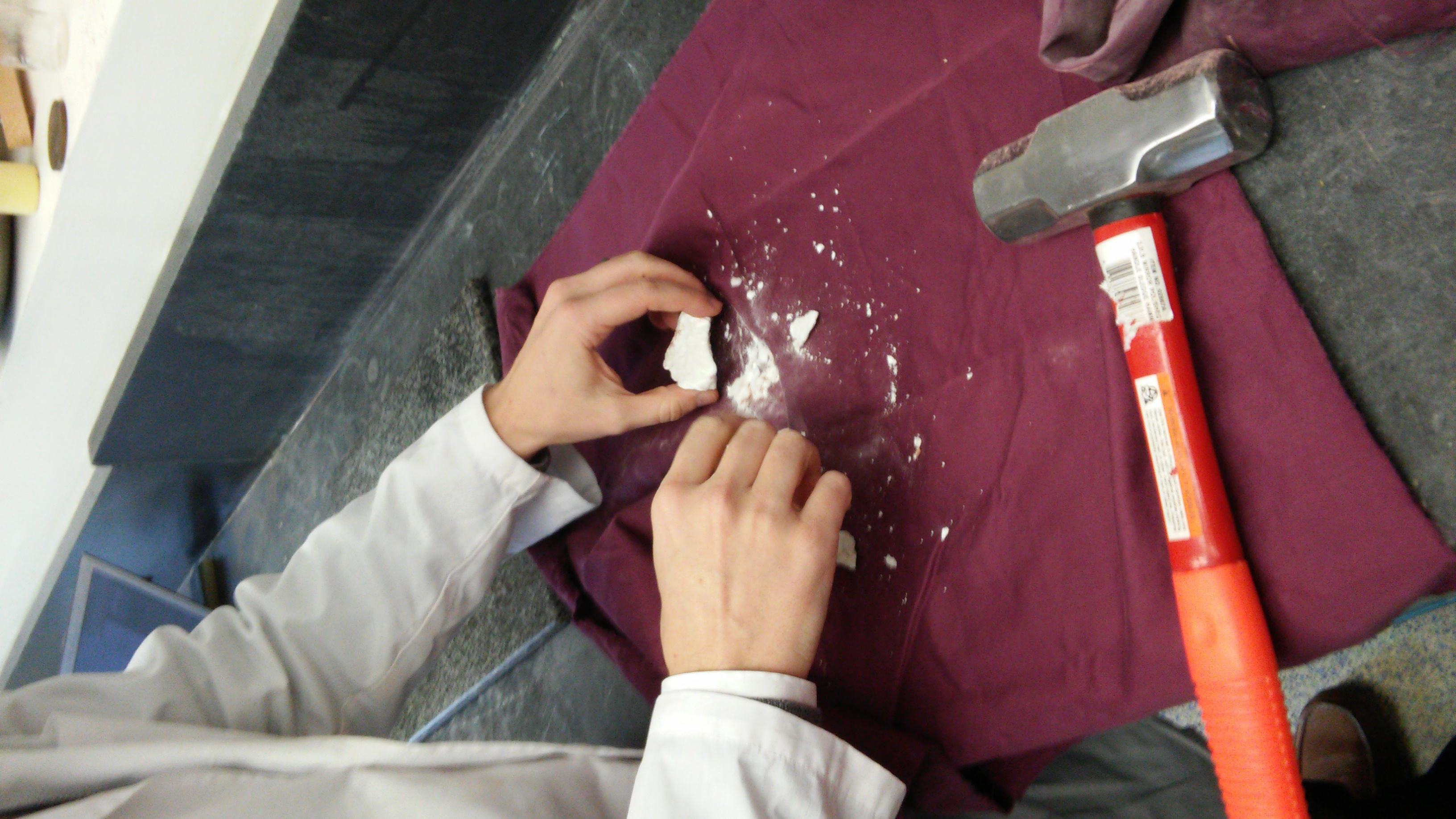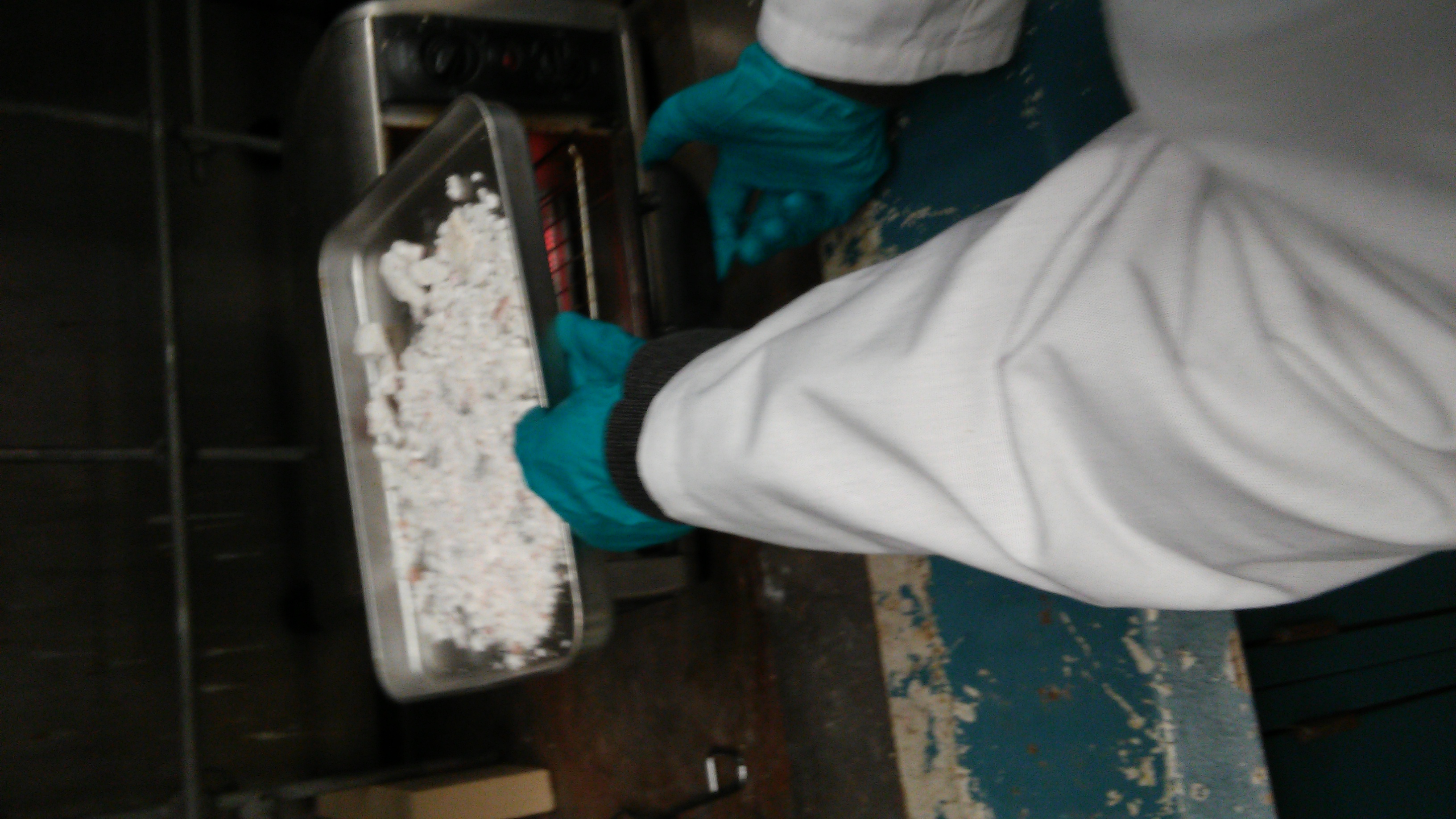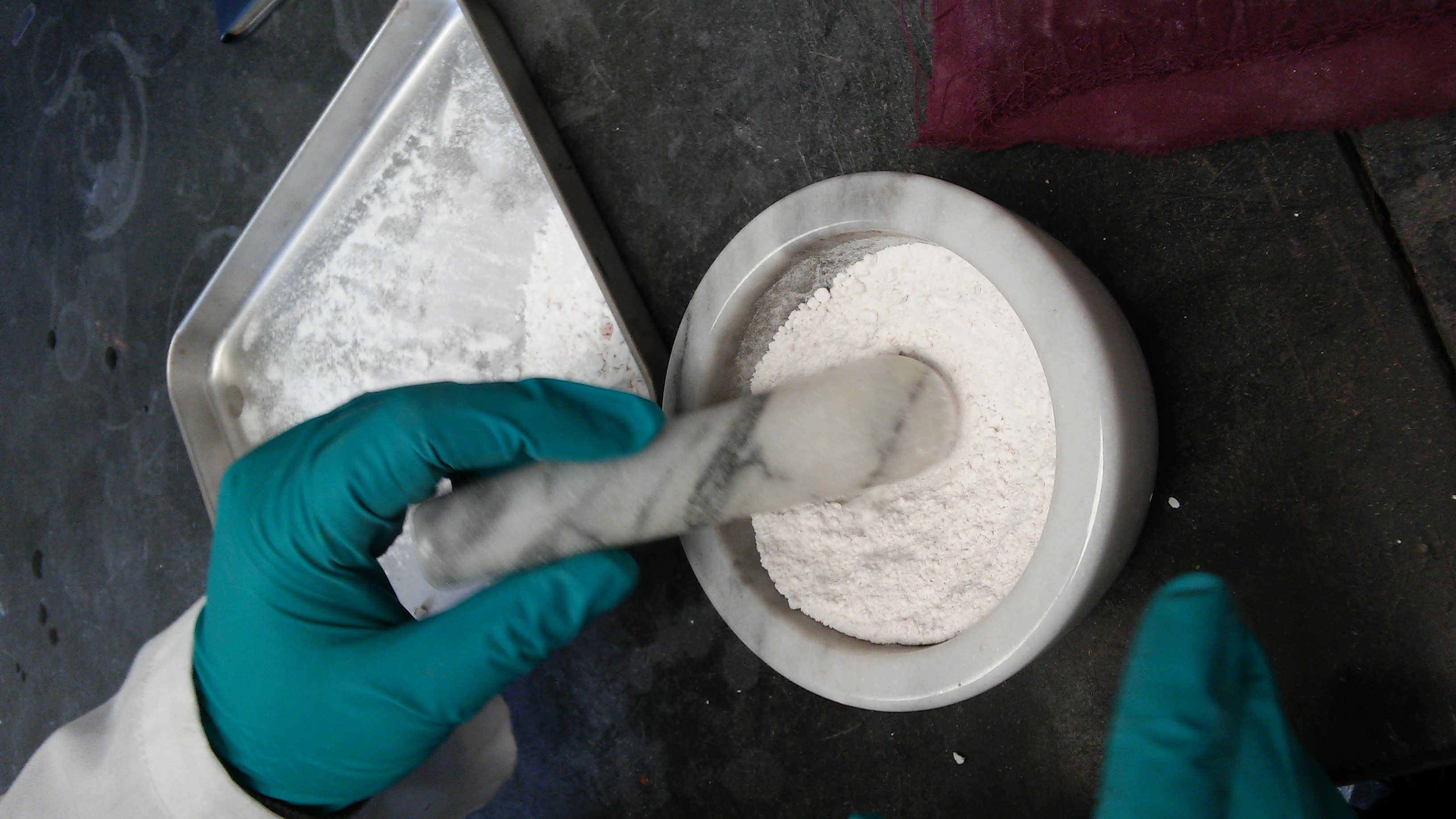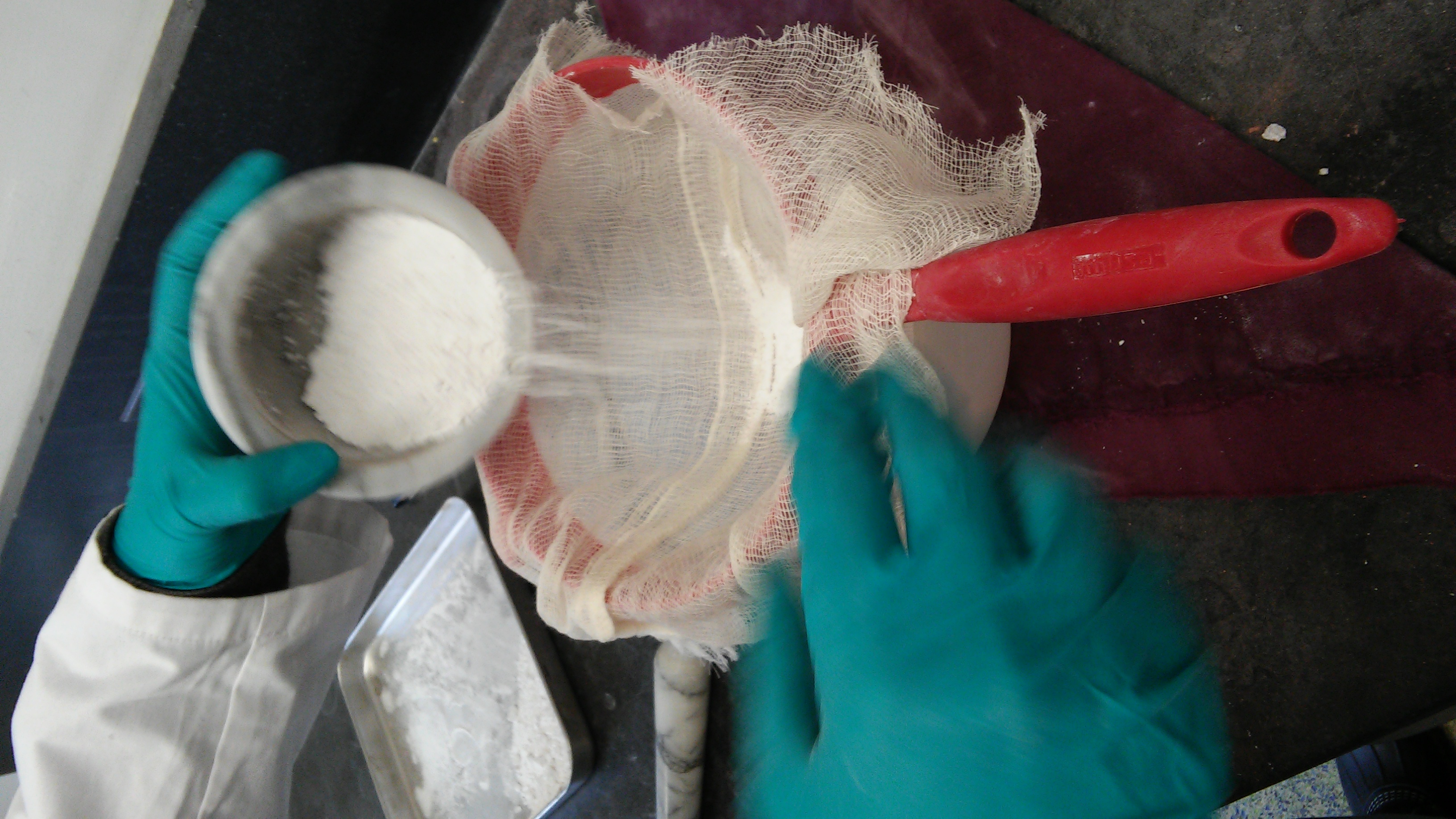Recipe:
<title id=”p083r_a6”>Sable excellent</title>
<ab id=”p083r_b6”>Albastre calcine dans un crusol a foeu de charbon tant quen le<lb/>
touchant il vienne en pouldre Esta{n}t froit pulverises le subtilem{ent}<lb/>
& passes par un double tamis & le rendes co{mm}e impalpable Et d avecq<lb/>
une lb de albastre il fault une ℥ de sel armoniac Mesles bien<lb/>
& incorpores tout ensemble Puys le mettes dans une cave cave ou<lb/>
lieu humide et de ceste paste moulles ce quil vous fauldra & apres<lb/>
seiches le moule au foeu & y gectes tel metal quil vous plaira<lb/>
pendant que le sable est chault & vous gecteres aussy net que le principal<lb/>
& le sable sert tousjours le mectant en lieu humide & seichant au foeu</ab>
<ab id=”p083r_b6”>Burn alabaster in a crusol under charcoal fire until it turns into powder. Once [it is] cold, finely pulverise it through a sieve to make it impalpable. With a pound of alabaster, one should use an ounce of sal ammoniac. Mix well and incorporate everything together. Next, put it in a cave or a wet location. And with this paste, mold whatever you need and then dry the mold under a fire. While the sand is hot, you cast whatever metal you may like and your cast will be as neat as the principal. And the sand [will]always work if it is kept in a wet location and dried by the fire.</ab>
NAME: Celia Durkin and Sofia Gans
DATE AND TIME: Monday Feb 23, 2015 10:00 am 69 degrees F
LOCATION: 260 Chandler
SUBJECT: Burning Alabaster
Burning Alabaster
Table of Contents
- Recipe for burning alabaster states: Burn alabaster in a crusol under charoal fire until it turns to powder
- Questions: how to burn alabaster? How long to burn it?
- first we thought to burn it in a kiln. However, after researching properties of alabaster, we found that the process of calcining would release water, possibly too much for a kiln, leading to rust etc.
- We then thought to possibly make our own furnace, but then decided on a toaster oven. We came to this conclusion by finding that Alabaster changes into plaster of paris at 300 degrees F, which is easily reachable with a toaster oven.
- First we needed to crush the alabaster into smaller pieces, so as to create more surface area to more easily release moisture
- Recipe states to burn until the stone turns to powder when touched. We decided to do a trial run with a small amount of stone. We crushed the stone with a sledge hammer, and placed the crushed alabaster in a metal tray in the toaster oven at 350 degrees. We decided to check the temp every 2 mins.
- 2 min: 300 degrees, 4 mins: 280 degrees, 6 mins: 302 degrees
- at 7 mins, we decided to bump up the temperature to 400 degrees and check less frequently
- at 11 mins, the stone was 336 degrees. It looked whiter, probably a sign of dehydration
- 15 mins, 357 degrees; the stone began to feel crumbly. The smaller pieces fall apart somewhat easily, however still required pressure.
- 20 mins: 381 degrees
- 25 mins: same temp, more crumbly
- 30 mins: 434 degrees, same consistency as before
- 46 mins: 378 degrees, tiny pieces falling apart; big pieces are powdery on the surface
- 60 mins: 520 degrees, very hot
- 75 mins: jiggled tray and some pieces turned to powder
- (Note: at 70 mins boredom and tiredness setting in. Celia succumbed to hunger and took a coffee break)
- 90 mins: still the same. Looks very white. We decided to take it out at 95 mins
- We then realized that the original recipe says to gently grind the rocks after letting them cool
- we let the alabaster cool for 13 mins, and then ground it into fine "impalpable" sand with a mortal and pestle.
- we then hammered out the rest of the alabaster, and divided it amongst the two of us, each to take home and back in our own ovens


DATE AND TIME: Weds, Feb 25, 2015 9:00 am 69 degrees F
LOCATION: 260 Chandler
SUBJECT: Grinding Calcined Alabaster/ Mixing it will Sal Amoniac
Grinding Calcined Alabaster/ Mixing it with Sal Ammoniac
- After each of us had baked our batches of alabaster in the oven at home: we compared notes on respective baking conditions:
- Celia: baked her alabaster at 350 degrees for 90 mins and then at 400 degrees for 30 mins
- Sofia: baked her alabaster at 500 degrees for 90 mins
- We each ground our baked alabaster into a fine powder, and decided to use two different ratios of sal amoniac, as we found two different recipes in the manuscript. One called for a ratio of 1 oz of sal amoniac to 1 lb of alabaster, the other, on folio 089v, called for 2 oz of sal amoniac to 1 lb of alabaster
- we split each recipe in half, ground the sal amoniac, and added it to the mixture
- we then pondered about the way to moisten the mixture. The recipe calls for letting the mixture sit in a humid cave. We had decided to use a humidifier.
- Unfortunately, we found that the humidifier in the lab was actually a salad tosser, so we decided to make our own humid "cave" in one of the cabinets
- we put damp cloths over the bowls of mixture, and added damp cloths around the cabinet, and let the mixture sit overnight


DATE AND TIME: Thurs, Feb 26, 2015 9:00 am 69.3 degrees F
LOCATION: 260 Chandler
SUBJECT: Moistening mixture, packing sand, baking molds
Moistening mixture, Packing sand, Baking Molds
- Upon checking our sand, we found it to be potentially slightly damp, but definitely not a paste. The cloths were dry, however.
- We pondered how much water we should add to the mixture in order to get the sand to hold together. Neither of us knew how much water would actually be formed from condensation. We decided to add different amounts of water to each mix, by method of spritzing water with fingertips.
- Celia added 2 ml of water to her sand
- Sofia added 20 mil of water to her sand. Sofia's sand seemed to form a slight paste, while Celia's did not
- Because our sands were quite dry, we decided to pack the molds on top of bricks, so that the sand would not fall out
- we packed the sand over the plaster medals
- we put bricks and molds into the toaster oven. Because the recipe did not specify how long to re-bake the molds, we decided that we would bake them until the plaster mixture was "hard as stone". This is because a different recipe on molding plaster prescribed this.
- we baked the molds (in wooden boxes) at 400 degrees.
Fire!
- after about 35 mins, we checked our molds, and saw that steam was coming out of the toaster oven, and a strange residue appeared on the toaster oven window. We thought this was odd, but not dangerous.
- about 10 mins later, the wood inside the toaster oven had caught fire
- Sofia alerted Donna to the fire, and Donna put the fire out with the fire blanket.
- We decided to reconvene next week, and attempt the process again, this time not using a toaster oven to reheat the molds, and adding more water to the paste.
Notes on Translation:
- Looking back at the original french translation gave us more incite into the recipe:
- On burning the alabaster: original: "heat until when you touch it, it turns to powder" instead of "heat it until it turns to powder"
- seive in english, "double tammied cloth" in original
Procedural Notes:
- burning alabaster: should we be mixing or grinding it while it was baking?
- decided no, as they would probably have used terra cotta, and tiny pieces might have rubbed off into the alabaster
- was the 1 lb of alabaster before or after it was calcined?